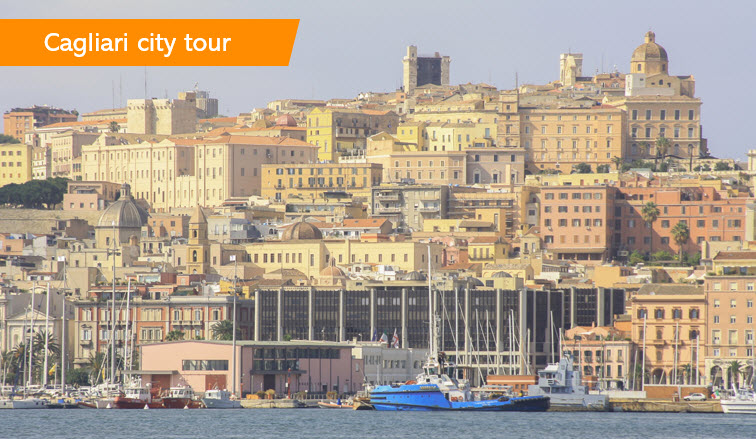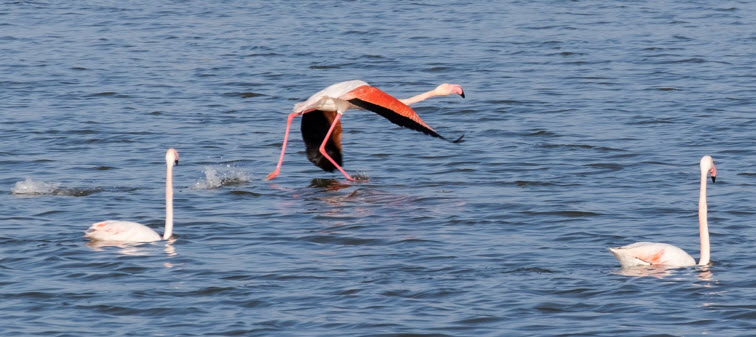Excursion 2 - Cagliari City Tour by bus

 Cagliari was founded in the 6th century BC by the Phoenicians, who created a commercial port of call in the interior of the lagoon of S. Gilla. Occupied by the Romans, the ancient Karalis had its Catrum in the Marina district, and grew, above all on the plain between the hills and the sea. In the Middle Ages, the villa giudicale was built near the S. Gilla lagoon. Later, the Pisans raised a line of defence around the limestone hills that dominate the gulf. The right to spend the night in the Castello district was given only to the Pisans: Cagliari, for all Sardinians, became Casteddu. Conquered after a siege by the Aragonese, in 1326, it became the capital of the Regnum Sardiniae. Now the old city is between the port and the Marina district, with the Stampace district to the west, and the Villanova district to the east. The white towers of the central Castello district overlook all of them.
Cagliari was founded in the 6th century BC by the Phoenicians, who created a commercial port of call in the interior of the lagoon of S. Gilla. Occupied by the Romans, the ancient Karalis had its Catrum in the Marina district, and grew, above all on the plain between the hills and the sea. In the Middle Ages, the villa giudicale was built near the S. Gilla lagoon. Later, the Pisans raised a line of defence around the limestone hills that dominate the gulf. The right to spend the night in the Castello district was given only to the Pisans: Cagliari, for all Sardinians, became Casteddu. Conquered after a siege by the Aragonese, in 1326, it became the capital of the Regnum Sardiniae. Now the old city is between the port and the Marina district, with the Stampace district to the west, and the Villanova district to the east. The white towers of the central Castello district overlook all of them.
Description of the sights
There are numerous important sights in Cagliari, only a few of each can be visited in a 3-hour bus guided tour.
- Quartiere di Castello and city center: Core originally from modern Cagliari, it is built on a rock that surmounts the heart of the city. Currently the area is rich in museums and historical sites, such as the Roman Amphitheatre, the Jewish Ghetto, the Bastion of Saint-Remy, the Duomo, the Palazzo Viceregio, the towers of San Pancrazio and of the Elephant, Piazza Yenne...
- Santuario di Nostra Signora di Bonaria: The Shrine is part of a complex of buildings which include the Basilica of Our Lady of Bonaria, the Sanctuary of Our Lady of Bonaria and the monastery. Our Lady of Bonaria is a Marian title associated with the Blessed Virgin Mary as Star of the Sea and patron of sailboats.
- Monte Urpinu: Natural park located in the heart of the city from which it is possible to admire, on one side, the east side with the beach and the salt flats, on the other, the west side where the hill on which the original nucleus of modern Cagliari has been built.
- Colle di San Michele: Ancient post fortress to protect the northern access of the city. On the top of the hill we find an Aragonese castle of the fourteenth century still in excellent condition and surrounded by the original moat. From this hill it is possible to admire the marvelous lagoon of Santa Gilla and the Golfo degli Angeli.
- Spiaggia del Poetto: The Poetto is the longest urban beach in Europe with a length of about 10 km along which there are bars, restaurants, aggregation centers, cycle paths, points for sports practice, and its panorama of Capo S. Elia. The summit of this headland, because of its shape, is called the devil's saddle, Sella del Diavolo.
- In its central part the Poetto borders the old city salt pans and from this point it is possible to admire the colonies of Flamingos, in the Stagno di Molentargius, one of the most important lagoon environments in Europe because of its wildlife.


 Cagliari was founded in the 6th century BC by the Phoenicians, who created a commercial port of call in the interior of the lagoon of S. Gilla. Occupied by the Romans, the ancient Karalis had its Catrum in the Marina district, and grew, above all on the plain between the hills and the sea. In the Middle Ages, the villa giudicale was built near the S. Gilla lagoon. Later, the Pisans raised a line of defence around the limestone hills that dominate the gulf. The right to spend the night in the Castello district was given only to the Pisans: Cagliari, for all Sardinians, became Casteddu. Conquered after a siege by the Aragonese, in 1326, it became the capital of the Regnum Sardiniae. Now the old city is between the port and the Marina district, with the Stampace district to the west, and the Villanova district to the east. The white towers of the central Castello district overlook all of them.
Cagliari was founded in the 6th century BC by the Phoenicians, who created a commercial port of call in the interior of the lagoon of S. Gilla. Occupied by the Romans, the ancient Karalis had its Catrum in the Marina district, and grew, above all on the plain between the hills and the sea. In the Middle Ages, the villa giudicale was built near the S. Gilla lagoon. Later, the Pisans raised a line of defence around the limestone hills that dominate the gulf. The right to spend the night in the Castello district was given only to the Pisans: Cagliari, for all Sardinians, became Casteddu. Conquered after a siege by the Aragonese, in 1326, it became the capital of the Regnum Sardiniae. Now the old city is between the port and the Marina district, with the Stampace district to the west, and the Villanova district to the east. The white towers of the central Castello district overlook all of them.
